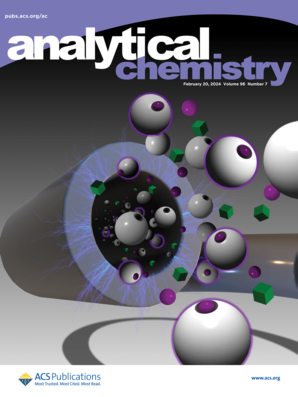使用逻辑纳米流体平台的胰腺特异性核酸和蛋白质生物标志物的多路检测。
IF 6.7
1区 化学
Q1 CHEMISTRY, ANALYTICAL
引用次数: 0
摘要
胰腺癌的早期发现对患者的生存至关重要。然而,目前的诊断方法仍然受到单一生物标志物检测策略固有的精度和特异性不足的限制。在此,我们开发了一个纳米通道生物传感平台,实现胰腺特异性生物标志物CA19-9和miRNA-196a的双信号协同检测。利用液-液界面自组装技术,构建了带有表面修饰双键DNA纳米锁的阳极氧化铝(AAO)-Au杂化纳米通道。miRNA-196a触发DDN逻辑门控的构象开关,暴露ca19 -9适配体,实现特异性靶标识别和相应的离子电流信号衰减。同时,通过催化发夹组装和杂交链反应介导的级联扩增对释放的miRNA-196a进行定量。实验表明,基于ddn的逻辑纳米流体平台对CA19-9的检测限为0.000027 U·mL-1,对miRNA-196a的检测限为4.74 aM,比传统的ELISA/qPCR方法提高了2-3个数量级。最后,临床样本分析证实了该平台在区分健康人胰腺癌和急性胰腺炎方面的高特异性。这种ddn功能化的纳米流体生物传感器为设计精确的胰腺癌检测平台提供了有价值的见解,突出了其在临床诊断中的重要潜力。本文章由计算机程序翻译,如有差异,请以英文原文为准。
Multiplexed Detection of Pancreatic-Specific Nucleic Acids and Protein Biomarkers Using a Logic Nanofluidic Platform.
Early detection of pancreatic cancer is vital for patient survival. However, current diagnostic approaches remain constrained by insufficient precision and specificity inherent to single-biomarker detection strategies. Herein, we develop a nanochannel biosensing platform implementing cooperative dual-signal detection of pancreatic-specific biomarkers CA19-9 and miRNA-196a. Using liquid-liquid interface self-assembly, we constructed anodic aluminum oxide (AAO)-Au hybrid nanochannels integrated with a surface-modified double-key DNA nanolock (DDN). The conformational switch of DDN logic gating triggered by miRNA-196a exposes the CA19-9-aptamer, enabling specific target recognition and consequent ion current signal attenuation. Simultaneously, released miRNA-196a is quantified by catalytic hairpin assembly and hybridization chain reaction-mediated cascade amplification. Experiments show that the present DDN-based logic nanofluidic platform could achieve an ultralow detection limit of 0.000027 U·mL-1 for CA19-9 and 4.74 aM for miRNA-196a, which is 2-3 orders of magnitude higher than traditional ELISA/qPCR methods. Finally, clinical sample analysis confirms the high specificity of this platform in distinguishing pancreatic cancer and acute pancreatitis from healthy individuals. This DDN-functionalized nanofluidic biosensor provides valuable insights into designing precision detection platforms for pancreatic cancer, highlighting its significant potential for clinical diagnostics.
求助全文
通过发布文献求助,成功后即可免费获取论文全文。
去求助
来源期刊

Analytical Chemistry
化学-分析化学
CiteScore
12.10
自引率
12.20%
发文量
1949
审稿时长
1.4 months
期刊介绍:
Analytical Chemistry, a peer-reviewed research journal, focuses on disseminating new and original knowledge across all branches of analytical chemistry. Fundamental articles may explore general principles of chemical measurement science and need not directly address existing or potential analytical methodology. They can be entirely theoretical or report experimental results. Contributions may cover various phases of analytical operations, including sampling, bioanalysis, electrochemistry, mass spectrometry, microscale and nanoscale systems, environmental analysis, separations, spectroscopy, chemical reactions and selectivity, instrumentation, imaging, surface analysis, and data processing. Papers discussing known analytical methods should present a significant, original application of the method, a notable improvement, or results on an important analyte.
 求助内容:
求助内容: 应助结果提醒方式:
应助结果提醒方式:


